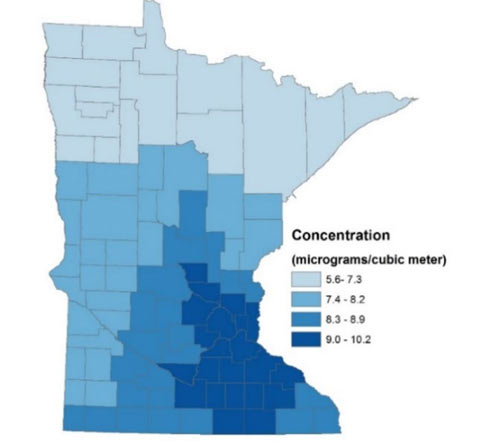
Dangerous Air In The Heartland

When dangerous air quality makes the news it usually showing up in places with large urban population centers or prevalence of heavy industry. For example, the wildfires that raged in California generated a lot of press when smoke from those fires blanketed Los Angeles and San Francisco. And, the resulting public attention could then be focused on pollution caused by cars or improperly regulated factories. But, heartland cities often cited as having very good air quality rarely make the headlines. It was surprising to many to find out this week that poor air quality was responsible for between two thousand and five thousand deaths in Minnesota between 2013 and 2019. With around five million residents, it is the 22nd most populous of the fifty states. And, it does not have an economy dependent on dirty industries. In fact, Minnesota has some of the nation’s strictest environmental standards. All diesel fuel dispensed in the state must contain 2% bio sources, and it is a leader in both wind and solar energy production. Air quality statewide meets all federal clean air standards So, what is going on?
Minnesota’s Air Quality Problem
This month the Minnesota Department of Public Health partnered with the Pollution Control Agency to release a report titled Life and Breath, which hoped to address the underlying issues of the air quality problem. It discovered that while pollution levels across the state were fairly uniform, particulate matter (PM 2.5) were most prevalent in the Twin Cities metro area, which is the largest city in the state and home to approximately fifty-five percent of the population. The problem disproportionately affects seniors, children, and people living without health insurance or regular contact with health care providers. Nevertheless, air quality is a problem for all Minnesotans regardless of whether they live in an urban or rural environment.
The primary air quality issue in Minnesota is the fine particulate matter or PM 2.5. This is a mix of fine dust and gas with a diameter of 2.5 micrometers (millionth of a meter) or less. PM 2.5 sources are abundant in the state and include vehicles, tractors, construction equipment, power plants, and fossil fuel burning. Particulate matter can travel very large distances in the air. So, while the levels may be most prevalent near roadways or areas with greater population density, it becomes problematic over a wider geographic region.
PM 2.5 can cause immediate problems like shortness of breath, wheezing, or coughing. However, prolonged exposure leads to more serious conditions like COPD and heart disease. Children exposed to PM 2.5 can develop Asthma and Allergies. Elderly people are at a heightened risk of stroke and heart attack. Even minute changes to PM 2.5 levels can have a dramatic impact on these health outcomes. The map to the right shows the concentration of PM 2.5 in the air recorded for each county in the state. The darker the shade of blue, the more concentrated the PM 2.5.
The state of Minnesota has achieved great things where environmental justice is concerned. It has air quality consistently below federally mandated thresholds, has been very successful in the utilization of alternative energy sources, and has sustainable forestry practices. But, the state is not content to rest on its laurels. It has set a ten percent statewide air pollution reduction target, and has ambitious goals for improving health equity for the most vulnerable among the population. In our view, that is a noble goal. However, air pollution targets are often difficult to achieve. The reason for this is that there is only so much the state can control. Regulation can be used to limit things like vehicle emissions, or the use of fossil fuels in generating electricity. However, PM 2.5 can originate from natural sources as well. Last year, wildfires in Canada dramatically increased PM 2.5 levels. Minnesota also borders four states, which do not have the same strict environmental standards. And, it is not unusual for PM 2.5 to travel via air currents from nearby pollution sources. Industrial centers like Chicago and Milwaukee are not far. And, plains states like Iowa, Nebraska, and the Dakotas are hot spots for large agricultural enterprises. Both of these sources are considered reasons for the higher concentrations in the central and southern regions of Minnesota. In fact, the rural southwest had the highest number of air pollution attributable deaths in the period under study. Thus, the statewide scope of the ten percent air pollution reduction goal. The report concluded that this reduction would have a meaningful impact on public health. It would lead to five hundred fewer deaths, seventy fewer hospitalizations, and one hundred fifty fewer emergency room visits all in a single year. Certainly a laudable goal, and hopefully achievable.
Thinking About Indoor Air

As the saying goes, we must hope for the best and prepare for the worst. In spite of what Minnesota hopes to achieve there are many factors working against them. A warming climate, a growing population, and neighboring state reluctance are all headwinds. There is also a considerable air quality problem the state has yet to address: indoor air quality. The US Environmental Protection Agency (EPA) has concluded that indoor air quality is up to five times more polluted than outdoor air. This is due to low air exchange rates with the outside combining with indoor air pollution sources to aggregate PM 2.5 and VOCs within the home. In colder states like Minnesota, this is even more of an issue because of the use of heating oil or fireplaces. Anyone who has ever experienced Minnesota in January, when temperatures frequently drop well below zero, or heard about it probably understands the tendency to spend most time indoors. And, this of course leads to higher air pollution risk. Hopefully, the state of Minnesota will embrace indoor air quality issues in their statewide plans, and include air sanitizers in their health equity goals. This would go a long way in helping them achieve better health for all residents of the state. Even, if they fail to achieve their progressive outdoor standards, they can at the very least ensure that time spent indoors is healthy.
The unfortunate drawback to these and other studies relating air pollution to brain disease is that the focus is on the outdoors. This is also the focus on any legislative or regulatory attempt to control air pollution. What gets left out in these efforts is the indoors. And, this is no small thing. The EPA has noted that indoor air pollution is two to five times worse indoors than out. The reason for this is the way an HVAC system works. The typical air handler in a home, office, or public space has a fresh air replacement rate of only thirty percent. This makes it easy for particulate from the outdoors to accumulate indoors and limits the exhaustion of indoor sources of air pollution (stoves, fireplaces, carpets, finishes, etc). Given the significance a single microgram of particulate has, this is very troublesome. While it is clearly a threat to anyone, seniors are a higher risk group. They spend more time in indoor settings, are less active, and closer to the onset of Dementia.
Again, no one loves being in the position of having to tell a respected parent they are no longer able to live on their own. It is probably one of the most stressful moments of anyone’s life. However, it is something that most of us will have to face with courage. When the time comes, we have a special responsibility to make sure that their time in a long term care facility is as pleasant and meaningful as possible. Credible research has linked air pollution to Alzheimer’s Dementia. Air pollution is more prevalent inside than out. And, seniors spend more time indoors. So, it is our responsibility to look for proven indoor air sanitization methods that will diminish the likelihood of a parent developing Dementia.

